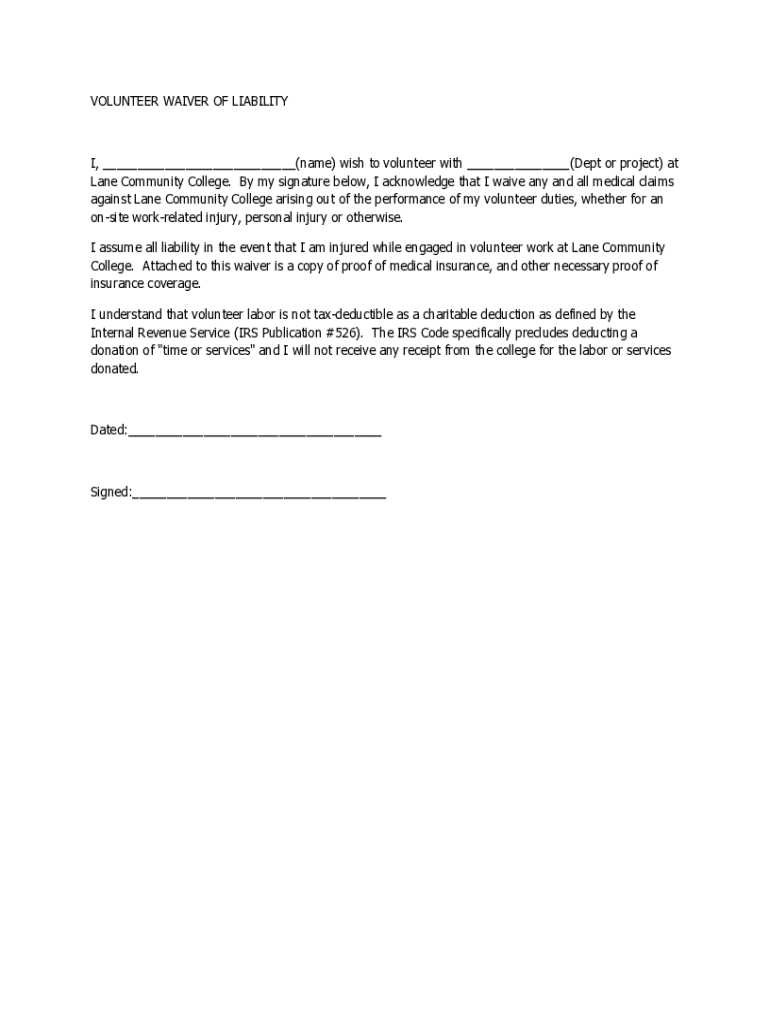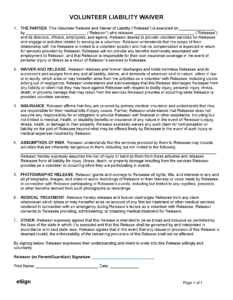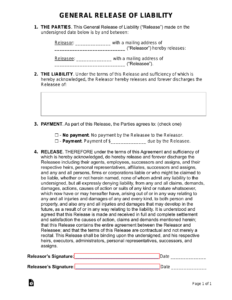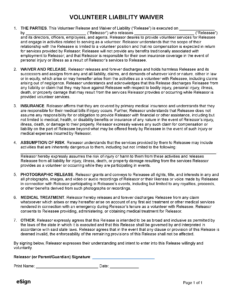Utilizing such a document promotes a clear understanding between organizations and their unpaid workforce. This clarity protects the organization from unwarranted legal action while ensuring volunteers are aware of potential hazards. It fosters a transparent and safe environment where individuals can contribute their time and skills without ambiguity regarding responsibility. This ultimately facilitates a smoother and more secure volunteering experience for all parties involved.
The following sections will explore the key components of these crucial documents, including essential clauses, legal considerations, and best practices for implementation.

Key Components of a Volunteer Waiver Form
Effective volunteer waiver forms contain essential elements that ensure clarity and legal soundness. These components work together to protect both the organization and the volunteer. A well-drafted document minimizes misunderstandings and potential disputes.
1. Identification of the Parties: Clear identification of the volunteer and the organization is paramount. Full legal names and addresses should be included for accurate record-keeping and unambiguous reference.
2. Description of Activities: A comprehensive description of the volunteer activities, including specific tasks and potential locations, is essential. This specificity helps volunteers understand the scope of their involvement and associated risks.
3. Assumption of Risk: This section outlines the inherent risks associated with the volunteer activities. It should clearly state that the volunteer understands and accepts these risks, acknowledging the possibility of injury or harm.
4. Release of Liability: This crucial component states that the volunteer agrees not to hold the organization liable for injuries or damages sustained during their service, except in cases of gross negligence or intentional misconduct. Specific legal terms should be used to ensure enforceability.
5. Indemnification Clause: This clause protects the organization from financial loss due to claims arising from the volunteer’s actions. It states that the volunteer will compensate the organization for any such expenses, excluding situations involving organizational negligence.
6. Severability Clause: This ensures that if any part of the waiver is deemed invalid, the remaining sections remain enforceable. This maintains the overall integrity of the document.
7. Signature and Date: The volunteer’s signature and the date of signing are essential for demonstrating informed consent and agreement to the terms of the waiver.
8. Witness Signature (Recommended): While not always required, a witness signature can provide additional validation and legal reinforcement of the agreement.
Careful consideration of these components ensures a comprehensive and legally sound document. A well-drafted waiver clarifies expectations, minimizes potential liabilities, and fosters a safe and transparent volunteering environment.
How to Create a Volunteer Waiver Form
Creating a robust volunteer waiver form requires careful attention to detail and a thorough understanding of legal implications. A well-drafted document protects both the organization and its volunteers. The following steps outline the creation process:
1. Consult Legal Counsel: Legal advice is crucial to ensure the waiver complies with applicable laws and regulations. An attorney specializing in non-profit law can provide invaluable guidance.
2. Identify the Organization and Volunteer: Clearly state the full legal names and addresses of both the organization and the volunteer. This ensures unambiguous identification of the parties involved.
3. Describe Volunteer Activities: Provide a comprehensive description of the specific tasks and location(s) where the volunteer will be active. This clarifies the scope of volunteer involvement.
4. Outline Inherent Risks: Clearly articulate the potential risks associated with the described activities. This informs volunteers of potential hazards and demonstrates transparency.
5. Include an Assumption of Risk Clause: This section should state that the volunteer acknowledges and accepts the inherent risks associated with the activities.
6. Draft a Release of Liability: This crucial clause states that the volunteer will not hold the organization responsible for injuries or damages unless caused by gross negligence or intentional misconduct on the part of the organization.
7. Add an Indemnification Clause: This clause protects the organization from financial liability arising from claims related to the volunteer’s actions, excluding instances of organizational negligence.
8. Include a Severability Clause: This ensures that if any part of the waiver is deemed invalid, the remaining portions remain enforceable.
9. Provide Space for Signatures and Dates: Include designated spaces for the volunteer and a witness (if applicable) to sign and date the document.
10. Review and Update Regularly: Periodic review and updates ensure the document remains current and aligned with evolving legal requirements and organizational practices.
A comprehensive and legally sound waiver form requires careful drafting and attention to detail. These steps provide a framework for creating a document that protects both the organization and its volunteers, fostering a safe and legally compliant volunteering environment. Regular review and updates are essential to maintain the document’s effectiveness and relevance.
Careful consideration of the elements within these documents, including clear identification of parties, detailed activity descriptions, and robust liability releases, provides crucial protection for organizations and volunteers alike. Understanding the legal implications and best practices for implementation is essential for creating a safe and legally sound volunteering environment.
Ultimately, a well-drafted document fosters transparency and trust between organizations and their volunteers, contributing to a more secure and positive experience for all involved. Proactive risk management through such documentation is paramount to the continued success and sustainability of volunteer programs.



